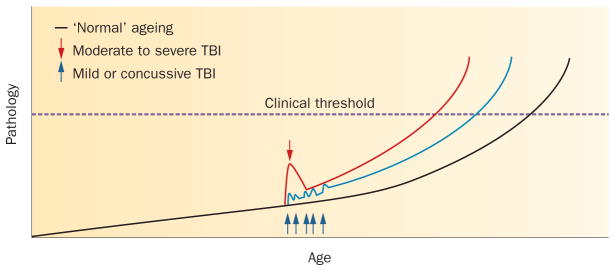Figure 4.

Interaction between TBI and ‘normal’ ageing: a hypothesis. An increasing range of pathologies is recognized in association with survival from TBI, any of which may contribute to the associated clinical syndromes of neurocognitive impairment. In the absence of a history of TBI, many of these same pathologies, such as amyloid-β plaque or neuroinflammatory pathology, may accumulate as a consequence of ’normal’ ageing (black line), with the accumulated pathologies eventually crossing a threshold where clinical symptoms are apparent. Following a single moderate to severe TBI, evidence to date supports an initial spike in pathology immediately after the event, which subsequently resolves. However, it is intriguing to speculate that, in a proportion of patients, there is incomplete resolution of this acute-phase response, with subsequent accelerated accumulation of pathology, leading to the threshold for clinical symptoms being crossed at an earlier age (red line). Similarly, each successive mild TBI may lead to acute pathology, again followed by partial resolution, but ultimately triggering accelerated accumulation of pathology, leading to earlier-onset symptomatology (blue line). Abbreviation: TBI, traumatic brain injury.
